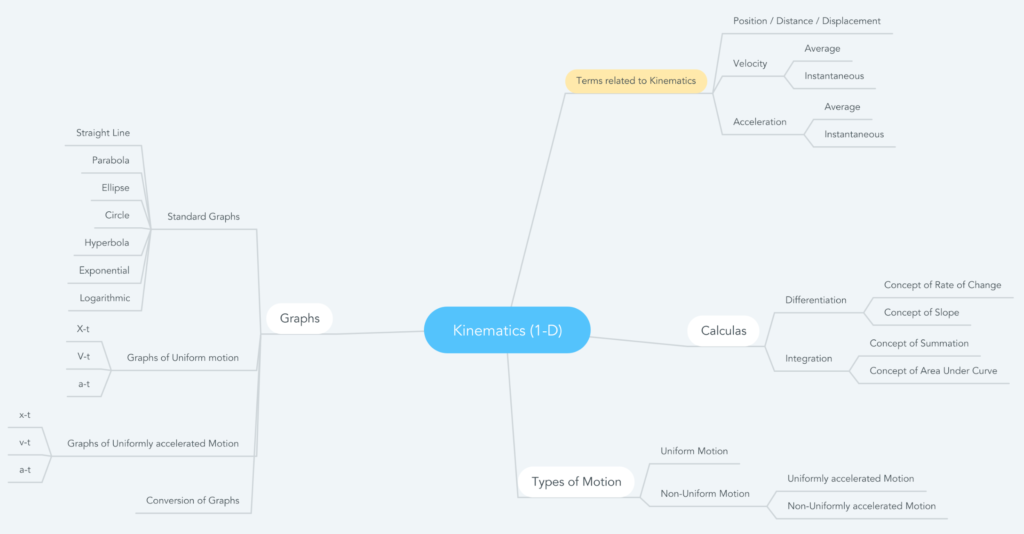Kinematics, the foundation of mechanics, forms a crucial chapter for acing the JEE Physics exam. It equips you with the tools to analyze and describe the motion of objects, laying the groundwork for more advanced concepts. This ACEMI material will be your one-stop guide to conquering Kinematics!

Scalars and Vectors
In kinematics, it is essential to distinguish between scalar and vector quantities. Scalars, such as distance and speed, have only magnitude. Vectors, such as displacement, velocity, and acceleration, have both magnitude and direction.
- Distance and Displacement: Distance is a scalar quantity that refers to the total path length traveled by an object. Displacement is a vector quantity that refers to the change in position of an object, defined as the final position minus the initial position.
- Speed and Velocity: Speed is the scalar measure of how fast an object is moving, while velocity is the vector measure that describes how fast and in which direction an object is moving.
- Acceleration: Acceleration is the rate of change of velocity with time and is a vector quantity.
Equations of Motion
The equations of motion for uniformly accelerated rectilinear motion (motion in a straight line) are foundational in kinematics. These equations are:
First Equation of Motion:

Where 𝑣 is the final velocity, 𝑢 is the initial velocity, 𝑎 is the acceleration, and 𝑡 is the time.
Second Equation of Motion:

Where 𝑠 is the displacement.
Third Equation of Motion:

These equations can be derived from the definitions of acceleration and velocity and are applicable under the condition of constant acceleration.
Graphical Representation
Kinematics can be effectively understood using graphs. The three primary types of graphs used are:
- Position-Time Graphs: These graphs show how an object’s position changes over time. The slope of the position-time graph gives the velocity of the object.
- Velocity-Time Graphs: These graphs show how an object’s velocity changes over time. The slope of the velocity-time graph gives the acceleration, while the area under the graph gives the displacement.
- Acceleration-Time Graphs: These graphs show how an object’s acceleration changes over time. The area under the acceleration-time graph gives the change in velocity.
Motion in Two Dimensions
Kinematics in two dimensions involves vector analysis. Motion in two dimensions can be described by considering the horizontal and vertical components separately. Common examples include projectile motion and circular motion.
Projectile Motion: When an object is projected into the air, it follows a curved trajectory under the influence of gravity. The horizontal motion and vertical motion can be analyzed independently.
- Horizontal Motion:

- Vertical Motion:

Where 𝑣0𝑥 and 𝑣0𝑦 are the initial horizontal and vertical velocities, respectively, and 𝑔 is the acceleration due to gravity.
Circular Motion: In uniform circular motion, an object moves in a circle with constant speed. The velocity is tangential, and the acceleration is centripetal, pointing towards the center of the circle:

Where 𝑣 is the tangential speed and 𝑟 is the radius of the circle.
Relative Motion
Relative motion describes how the motion of one object appears from the viewpoint of another object. It involves adding or subtracting velocities vectorially. If two objects A and B have velocities 𝑣⃗𝐴vA and 𝑣⃗𝐵vB respectively, the velocity of A relative to B is:

Displacement
- The shortest distance from the initial position to the final position of the particle is called displacement. The displacement of a particle is measured as the change in the position of the particle in a particular direction over a given time interval. It depends only on final & initial positions.
- Displacement of a particle is a position vector of its final position w.r.t. initial position.
Distance
The length of the actual path between initial & final positions of a particle in a given interval of time is called distance covered by the particle. Distance is the actual length of the path. It is the characteristic property of any path ie., path is always associated when we consider distance between two positions.
Conclusion
Kinematics provides the tools necessary to describe and analyze the motion of objects without reference to the forces causing the motion. By understanding and applying the fundamental concepts of displacement, velocity, and acceleration, and by utilizing the equations of motion and graphical methods, students and physicists can predict and explain a wide range of physical phenomena. As the bedrock of classical mechanics, kinematics is essential for further study in both theoretical and applied physics.
JEE Advanced Previous Year Paper
JEE Advanced: 28-Aug-2022 ( Shift 1 )
JEE Advanced: 4-Jun-2023 ( Shift 2 )
Crack Admission Into IIT With PracBee’s 1:1 JEE Online Course
Effectively utilize limited time to completely revise JEE Advanced syllabus with our fully customized approach. It caters to your learning needs, helping you to easily crack the IIT-JEE Exam.
Key Features:
![]() All live classes in 1:1 mode
All live classes in 1:1 mode
![]() High Focus on Result
High Focus on Result
![]() 100% Personalized & Interactive classes
100% Personalized & Interactive classes
![]() Rated 5/5 by 95% students & parents
Rated 5/5 by 95% students & parents
![]() Weekly Feedback to Parents
Weekly Feedback to Parents
![]() 1:1 Mentorship by Senior IITian Faculty
1:1 Mentorship by Senior IITian Faculty




